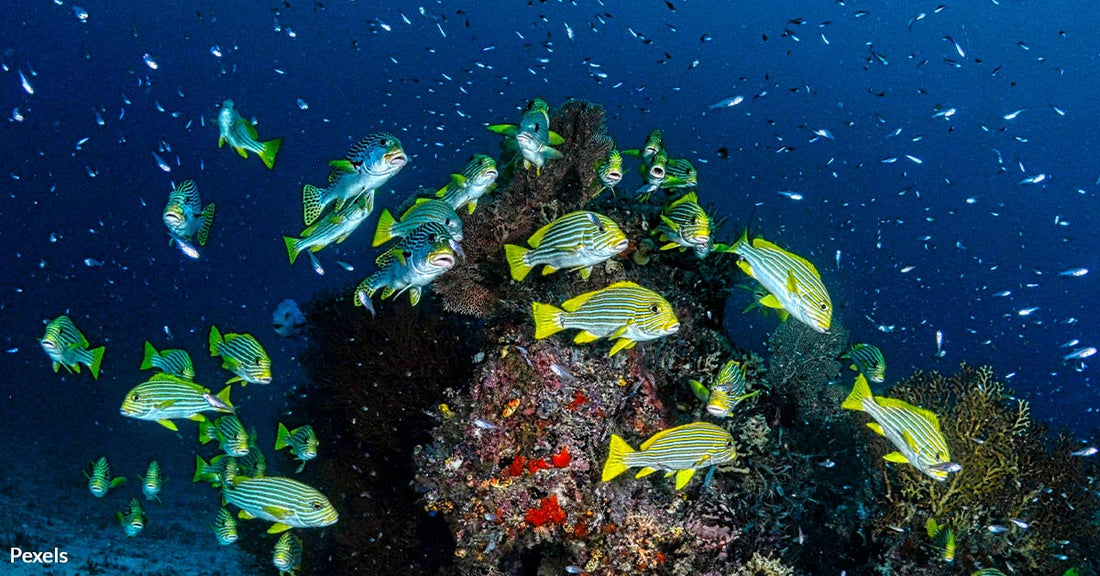Voracious Coral Predators Threaten Florida Reefs
Matthew Russell
Coral reefs in Florida face many challenges. A new study reveals that native coral-eating fish may play a more complex role in reef health than once thought.
Recent underwater footage captured by innovative doorbell-style cameras shows that redband parrotfish, foureye butterflyfish, and stoplight parrotfish are voracious consumers of newly outplanted corals, The Guardian reports. The discovery comes as researchers race to restore reefs that have lost over 90% of their coral cover in recent decades.

Photo: Pexels
Native coral-eating fish are targeting new coral outplants.
New Insights from Underwater Surveillance
Underwater cameras designed like doorbells have turned the tide in identifying coral predators. The system recorded fish nibbling on coral bait, providing clear evidence of which species target vulnerable corals.
Diego Lirman of the University of Miami told The Guardian, “Intense fish predation on newly outplanted corals has emerged as a major restoration bottleneck,” and he stressed the need to know which species are responsible.
The technology helped document that redband parrotfish account for more than half of the bites on coral bait, with foureye butterflyfish following and stoplight parrotfish contributing a smaller share. Short, direct video clips reveal a rapid sequence of bites and the uneven impact these species have on outplanted corals.

Photo: Pexels
Underwater doorbell cameras capture the action.
Ecological Role of Corallivores
The role of these coral-eating fish is not solely destructive. Studies indicate that when these fish feed on corals, they also disperse microscopic symbionts that corals need to thrive. Research published in Animal Microbiome shows that the feces of corallivores carry live Symbiodiniaceae cells, the algae that provide nutrients to coral hosts. This process may help transfer beneficial cells among coral colonies. Short bites may injure corals, but they could also help replenish vital symbiont populations. Scientists have noted that the presence of these algae in fish waste might create micro-hotspots that support coral recovery even amid predation.
Foraging Behavior and Coral Restoration Challenges
Corallivore foraging behavior has long been a subject of study. A recent academic work from Nova Southeastern University explores the factors dictating how these fish choose their meals. The study found that habitat structure, coral species composition, and individual fish preferences all affect predation rates.
Native fish show clear selectivity. They concentrate on certain coral species that may already be under stress from bleaching and other disturbances. Short, rapid bites leave visible scars on corals. These marks are a direct challenge for restoration efforts, where every outplanted coral counts. Researchers suggest that careful site selection, informed by detailed fish behavior studies, could reduce losses during coral restoration projects.

Photo: Pexels
Florida reefs struggle under mounting pressure.
Balancing Natural Functions and Restoration Efforts
The role of coral-eating fish is not entirely negative. Parrotfish, including redband parrotfish, are known to clean reefs by grazing on algae that suffocate corals. The Nature Conservancy explains that parrotfish help produce sand through their feeding activities and keep reefs healthy by reducing algal overgrowth. This dual role highlights a balancing act.
While some coral-eating fish remove live coral tissue, they also contribute to coral resilience by dispersing essential algae. This duality makes it hard to label them as purely harmful. Instead, they represent a complex component of reef ecosystems.

Photo: Pexels
Natural predators complicate human intervention.
Competing Threats and Future Directions
Florida’s reefs also face pressure from invasive lionfish. Unlike native corallivores, lionfish are non-selective predators that have invaded coastal waters from the Indo-Pacific. NOAA Fisheries reports lionfish reduce native fish recruitment and disrupt reef dynamics.
Although lionfish do not feed directly on corals, their presence adds to the challenges of reef restoration. In contrast, the native coral-eating fish offer insights into both negative and positive interactions with coral reefs. Managers now face a dual challenge: control the invasive lionfish while understanding and managing the impacts of native corallivores.

Photo: Pexels
Urgent measures are needed to protect reefs.
The emerging picture is nuanced. Native coral predators may hinder early restoration efforts by consuming young coral fragments. Yet, they also play a role in spreading beneficial symbionts and maintaining ecological balance. Restoration practitioners can use this knowledge to choose outplanting sites wisely. Avoiding areas with high densities of redband parrotfish or foureye butterflyfish might boost coral survival. In addition, integrating new technologies like AI to analyze underwater footage could further refine site selection. The ongoing research will guide effective strategies to promote coral recovery and reef resilience.
Florida’s reefs stand at a crossroads. Restoration efforts must account for natural predation and its hidden benefits. Combining detailed behavioral studies with cutting-edge surveillance promises to inform better management. The hope is that by understanding both the risks and rewards of coral predation, scientists and conservationists can steer reefs toward a more resilient future.

